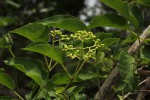| Home | > | List of families | > | Lamiaceae | > | Premna |
7185.000 Premna
Paton, A.J. et al. (2013) Lamiaceae Flora Zambesiaca 8(8) 1-346
Description of the genus
Trees, shrubs, climbers or subshrubs, glabrous to densely hairy. Leaves petiolate, opposite or 3–4-whorled, simple, entire or dentate, often with minute spherical glands, aromatic when crushed. Inflorescences terminal, usually many-flowered, with flowers in cymes corymbosely, racemosely or paniculately arranged, rarely the inflorescences axillary. Flowers small and dull-coloured; calyx usually actinomorphic, truncate to 3–5-dentate or 2–5-lobed, or sometimes c. 2-lipped; corolla tube short, infundibuliform or cylindric, villous or with a ring of hairs; limb 2-lipped, with the posterior lip 2-fid or emarginate and the anterior 3-fid or 3-partite, with the lobes subequal or the median one the largest. Fruit drupaceous, small, with a thin fleshy mesocarp and bony endocarp; calycine cup persistent, often venose. Seeds oblong, without endosperm. Worldwide: c. 200 species in tropical and warm regions of the Old World Caprivi: 1 taxon. Insects associated with this genus:
|
 |
Links to taxa: View: living plant images - herbarium specimen images - all images for this genus
| Species | FZ divisions | Content |
| senensis Klotzsch | Description, Image |
Other sources of information about Premna:
Our websites:
Flora of Botswana: PremnaFlora of Burundi: Premna
Flora of Malawi: Premna
Flora of Mozambique: Premna
Flora of Zambia: Premna
Flora of Zimbabwe: Premna
External websites:
African Plants: A Photo Guide (Senckenberg): PremnaBHL (Biodiversity Heritage Library): Premna
EOL (Encyclopedia of Life): Premna
GBIF (Global Biodiversity Information Facility): Premna
Google: Web - Images - Scholar
iNaturalist: Premna
IPNI (International Plant Names Index): Premna
JSTOR Plant Science: Premna
Mansfeld World Database of Agricultural and Horticultural Crops: Premna
Plants of the World Online: Premna
Tropicos: Premna
Wikipedia: Premna
| Home | > | List of families | > | Lamiaceae | > | Premna |